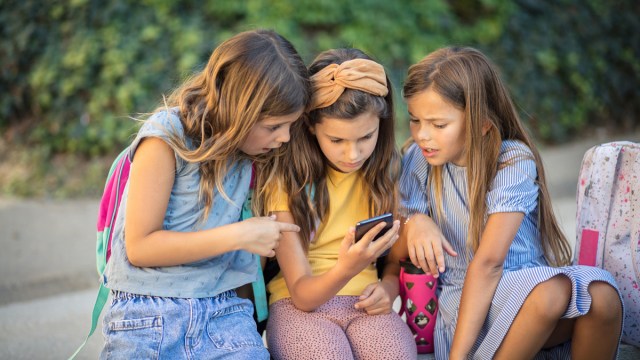If you’re thinking about getting your kid a phone but worried it’ll launch them into a life of social media scrolling or video games, you should know: not all phones are created equal. You can give your kid a cell phone for communication…without sending them freefalling into a life of TikTok dances and Snapchat streaks.
According to Common Sense Media, nearly half of kids (42%) have a phone by age 10. That number jumps to 71% by age 12 and 91% by age 14—with most parents admitting that they give their kids a phone for safety reasons.
But that doesn’t mean kids need an all-access pass! As parents get more and more savvy about the dangers of technology for kids, cell phone-makers are stepping up, making more specialized parental controls and specialized phones to keep kids safe.
So, whether you’re leaning toward an old-fashioned flip phone or a smartphone with built-in safeguards, here are our top picks for the best cell phones and phone watches for kids.
Best Phone for Monitoring (and Limiting) Your Child’s Screen Time: The Bark Phone
Unsurprisingly, the makers of one of the leading parental control apps have designed a phone with all those controls pre-loaded, giving parents full oversight of their child’s experience.
The Android smartphone (it’s a Samsung Galaxy, in case your kids care) is outfitted with all of Bark’s parental controls, a customizable array of settings that can be as strict or loose as you want them—from being able to “pause” all functions of your kid’s phone at the tap of a button (even when your child isn’t with you) to being able to set specific time limits for apps. Like any “regular” Android smartphone, kids can download apps from the Google Play Store, pending parent or guardian approval.
It also notifies you of any problematic behavior. Parents will love that the Bark app sends timely notifications if any messages, posts, or searches contain references to drugs, porn, bullying, and other potential concerns.
Bark Phone Pros:
– An extensive parental controls dashboard allows parents to limit apps, screen time, and downtime hours.
– The “Pause” button is great for turning kids “off” when needed (i.e., at dinner or bedtime).
– Screen time can be set for individual apps or for “all apps” as a whole.
– Parents can approve (or deny) a child’s contacts.
– Parents are notified of any potentially concerning texts, posts, or searches (i.e. bullying, pornography, strangers contacting kids, or drugs).
– GPS location monitoring is more accurate than other phones we tested.
– The geofencing option lets you know when your child leaves or arrives in a certain area.
– It’s difficult for even tech-savvy kids to bypass parental controls.
Bark Phone Cons:
– The monthly service fee, which covers both cell phone service and monitoring, is expensive compared to some other phones.
– The parental controls can be confusing and hard to navigate.
– Kids may get frustrated that they can’t load certain apps (like those specific to iPhones, for instance).
– Bark’s basic data plan has a 4 GB limit that will be used up quickly by most kids.
– While Bark will monitor posts and messages and notify you of concerning activity, it doesn’t always catch content within social media apps (sketchy near-naked video content on TikTok, for instance, may slip through).
– Bark uses its own network, so you can’t add the phone to your existing cell phone plan.
Cost: The phone is free from Bark.us when you sign up for a monthly plan; monthly plans start at $59/month for 4GB of data per month.
Online: Bark.us.
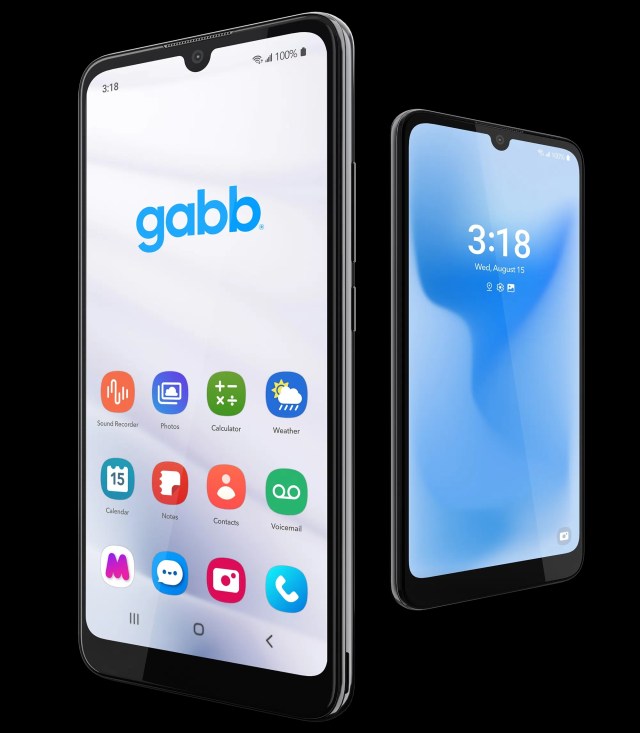
Best Zero-Internet Phone: The Gabb Phone 4
The Gabb phone is the perfect “first phone” for kids who can handle having a phone instead of a watch (I.e., they’re not going to leave it at school or a playground the first week of using it). Sleek and straightforward, Gabb uses a modified Android smartphone to give kids calling and texting capabilities—as well as “smart message filtration and GPS tracking”—without internet, gaming or social media features.
Kids will love the way it looks and feels (you’d never know it wasn’t a “real phone,” says our tester); parents will love that their kids can’t do much more than use it to communicate. The phone comes only with preloaded “essential” apps like Gabb messenger and a calculator, with “optional” apps that parents can add including chess and solitaire.
Gabb Phone Pros:
– The phone comes without an internet browser, app store, video games, or social media apps.
– Parents can set approved contacts, and the phone automatically blocks most spam calls.
– The simple interface offers only a few options: Calling, texting, music (with Gabb’s curated “clean” music library), camera, calculator, voice recorder, calendar, and clock (with stopwatch/ timer).
– Includes GPS location tracking with location updates.
– Kid-safe messaging uses smart filtration to flag all high-risk content or block incoming explicit images or video.
– “Locate Phone” function plays a sound on the phone to help your child find the phone when it’s lost in your home.
– No Internet, streaming video, or app store.
– The 13-megapixel camera is good for a low-cost phone.
Gabb Phone Cons:
– Parents can’t block the use of the phone at certain hours.
– Kids (especially tweens and teens) may balk at the idea of a phone that doesn’t do much more than call or text.
– Doesn’t work with your existing cell phone carriers; users must use Gabb wireless.
– May not appeal to older kids who want more features.
Cost: $100 for phone plus $18 for monthly service.
Online: Gabb.com
Best Phone for Giving Your Kids Apps… but Not “Those Apps”: Pinwheel Phone
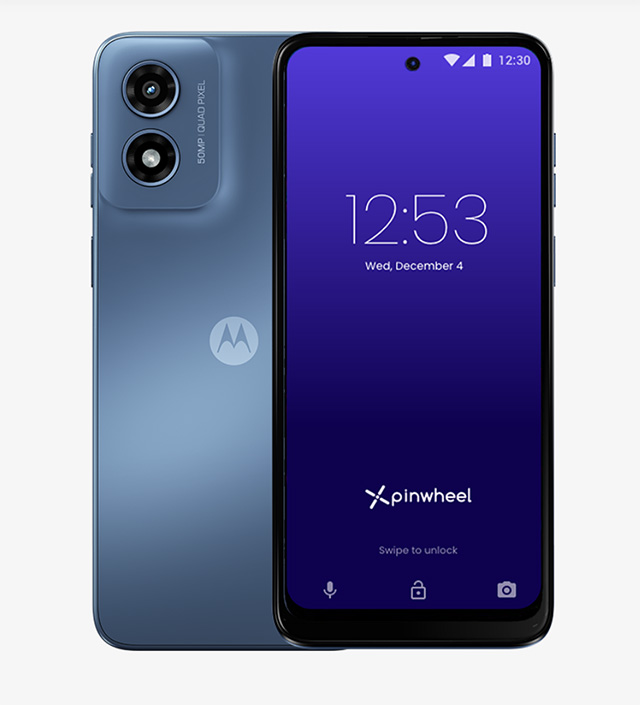
Billing itself as a “phone that grows up with your child,” the Pinwheel may be the best of both worlds for your little techie: It has tons of apps for your kid to peruse—but “approved” apps are only the ones deemed educational or enriching by Pinwheel’s team of curators. (Parents can allow other apps, but Pinwheel vets them and categorizes them into tiers so you know how harmful they might be for your child).
“Using a phone as entertainment doesn’t set kids up well for success,” said Pinwheel’s “Chief Mom” Shelley Delayne. “Using it as a tool to help manage their life, using it for communication, using it to learn new skills—those benefit a kid.”
That means YES to Kindle, Chess, and Scratch, and NO to TikTok, Instagram, and Facebook. Parents are given the control to pick and choose from the more than 250 curated apps and decide which—if any—should be available on their child’s device.
Pinwheel PhonePros:
– Parents can add Pinwheel’s curated library of about 1,200 apps to their child’s phone as they deem appropriate (or have no apps at all!).
– No access to the Internet, social media, or an app store.
– Parents can monitor text and call history as well as approve contacts.
– Parents can set time limits for phone use (such as turning it off during school hours or at bedtime).
– Pinwheel comes in several sleek designs, including a Pixel 8A, which will help kids “buy in” to the idea of the phone.
– You can see your child’s text messages and call history.
– GPS tracking and geofencing can keep digital tabs on your child.
– The phone can be added to your plan with most major cell phone carriers.
Pinwheel Phone Cons:
– The parental controls app is a bit confusing.
– Older kids may still resent the fact they can’t use social media or games of their choosing.
– Some loopholes may allow kids to get onto the internet (via links sent in e-mail, for instance).
– Depending on which phone model you choose (the Pixel 8A is $599, for instance), it can be more expensive than other “kid phones.”
Cost: Phones vary, with models starting at $99 (plus $17.99 a month for a Pinwheel subscription and whatever your carrier charges for an added phone line).
Online: Pinwheel.com
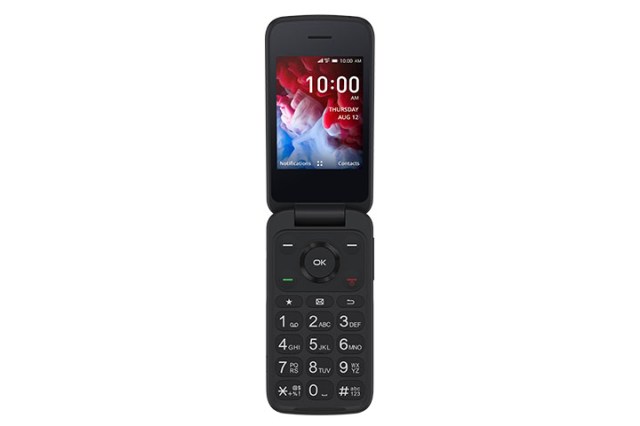
Best Flip Phone: TCL Flip Phone
If you want to make calls like it’s 1999, this is the phone for you. While we didn’t try this one ourselves, it topped the New York Times’ list for the ”Best First Phones for Kids.”
Mostly, that’s because it doesn’t let your kid do much more besides call and text—so if basic communication is your goal, this flip phone will check those boxes. It also has a basic camera and (limited, slow) access to the internet, so your kid can get online if they want to. That said, if you were of phone-owning age in the nineties, you’ll remember that typing anything via a numeric keypad was seriously not fun. Your kid will agree.
TCL Flip Phone Pros:
– Your kid won’t be able to do much more than make calls or text.
– No apps.
– There’s a basic camera.
– It’s cheap.
– Long battery life.
– Your kid will look totally retro! (Obviously, this is probably not a “pro” for your kid).
TCL Flip Phone Cons:
– No parental controls mean that you can’t track your child’s location, manage contacts, or monitor messages and calls.
– Group texts are virtually impossible for your kids to join (this may be a “pro” for you, but not for your kid).
– You can’t block spam or unknown calls.
– While it is slow and hard to access, your child can still use an internet browser on this phone.
– Some models (the Flip Pro) have an external SOS button, which is useful for teens, while younger kids may accidentally press the button.
Cost: There are several models (many are sold out online or hard to find); prices start at around $29.
Online: TCL.com
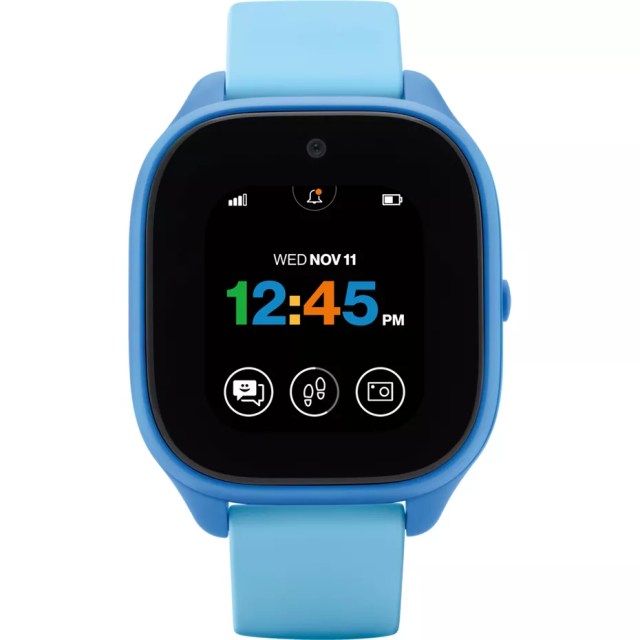
Best Phone Watch for Younger Kids (5-11): Verizon Gizmo Watch 3
This cute little watch is fun and colorful for kids to wear, and little kids will love that it has simple games and a step counter. Parents will love that it has accurate GPS tracking, easy geofencing (so they can be notified when a child leaves or arrives at a set area), and parental controls that make it impossible for kids to access the internet or contact anyone except pre-approved contacts. Some models also have rudimentary cameras, which is a bonus or a detriment, depending on your preference.
Gizmo Watch Pros:
– Only $10 per month.
– Only parent-approved contacts can call or text your child’s watch,
– The watch can’t access any internet content.
– Easy to use, with a handful of simple games like Tic Tac Toe and “Gizmo Says” (which is like Simon Says).
– Kids can send emojis or preset messages, including “When are you picking me up?” or “I love you.”
– Some models come with a camera (this can be a pro or a con, depending on your comfort level).
– Accurate GPS and geofencing.
– Parents can fill out Medical ID information via the app, which will be displayed via a widget on the phone.
Gizmo Watch Cons:
– You have to use the Gizmo app to send and receive text messages with your child, which is cumbersome.
– You must also open the app to track your child’s location (and we found that the location didn’t update as quickly as we would have liked).
– Certain functions (like the step counter and geofencing abilities) can drain the battery life.
– It can be hard for kids to hear you via the watch speaker (though to be fair, this is true for all phone watches).
– No music player.
– You can only get the phone with a Verizon plan (though you can open a dedicated account for the watch if you’re not already a customer).
Cost: $149 plus $10 per month added to your cellular plan.
Online: Verizon.com

Best Phone Watch for Younger Kids (Runner-Up): The Bark Watch
We love Bark—and its newly-released watch is a great little gadget for parents who want to track their kids’ whereabouts or use Bark’s extensive parental controls to monitor text messages. It has super-fast and accurate GPS-tracking, easy-to-use audio texting (tap-texting is not easy), and a basic camera younger kids will enjoy.
Bark Watch Pros:
– It’s lightweight and easy for kids to wear.
– No apps or internet access make it a good choice for kids under 10.
– Bark’s parental control app lets parents track location, set approved contacts, and monitor text messages.
– Geofencing options notify parents when and if their child leaves a set area.
– Bark parental controls can pause the watch or set screen time limits for messaging and calls.
– Parents are notified of any concerning text messages.
– There’s an SOS button on the side of the phone in case of emergencies.
Bark Watch Cons:
– Limited options may make it easy for kids to navigate (there’s not even a calculator) but may leave some kids underwhelmed.
– In addition to the side SOS button, Bark also lists 911 in the kids’ contacts list. This makes it way too easy for little fingers to accidentally call or text emergency services. (On my sample phone, for instance, 911 was listed right below “Mommy,” and the first time my daughter tried to text me, she instead texted a 911 operator, who told my daughter to “Stop playing with 911”).
– The watch has no step or activity counter, which would be a nice feature for parents who want to encourage physical fitness.
– Bark uses its own network, so you can’t add the watch to your existing cell phone plan.
Cost: $169 plus $15 per month plan.
Online: Bark.us/bark-watch

Best Phone Watch for Older Kids: Apple Watch SE GPS With Cellular
If you’ve got a tween and can afford an Apple watch, it’s a great option. After all, while the Apple Watch has a slew of app options, there’s not much social media browsing that can be done on a 1.5-inch screen, and the watch has no camera for your budding TikTokker to film herself doing who-knows-what. It’s also got a higher approval and reliability rating online than any of the kid-watches out there.
It’s not cheap, of course—which matters if your child is prone to leaving things behind. But it’s a great gadget with a number of fun apps that kids can use without becoming zombies to their screens. Plus, if you’re an Apple family, you can use Apple’s Screen Time features to disable various apps of your choosing.
Apple Watch SE Pros:
– They’re reliable and work with all major carriers.
– Parents can use Apple Screen Time to pause the device, set screen time hours, limit explicit content, and restrict apps and contacts.
– Kids won’t be as reluctant to use it since it’s not a “kiddish” watch and appeals to adults as well.
– If you’re an Apple family, it’s easy to track your kid’s location.
– Apple Watch’s activity rings can track your child’s steps and overall fitness.
– Optional Apple Care (which costs $49 for two years) will repair or replace your child’s watch if it breaks (though it doesn’t cover lost watches).
– Newer model Apple watches are waterproof, which is helpful, especially at crowded waterparks and beaches.
– Apple’s Screen Time settings can pause the watch, limit contacts, block callers, and set screen time.
– The watch’s cell phone number can eventually be transferred to a phone.
Apple Watch SE Cons:
– It’s expensive, starting at $299.
– The watch may have too many options and controls to easily navigate, and may be distracting.
– It’s hard to block spam texts and calls.
– Screen time settings can glitch, giving kids the ability to access inappropriate content on their watches.
– It can be difficult to block or limit group texts.
– Parents can’t see messages their child receives
– Since this is an adult device, it takes some tech-savvy to successfully navigate Apple’s Screen Time controls. Similarly, tech-savvy kids can find loopholes.
Cost: $299
Online: Apple.com
If you buy something from the links in this article, we may earn affiliate commission or compensation. Prices and availability reflect the time of publication.
All images courtesy of retailers.
